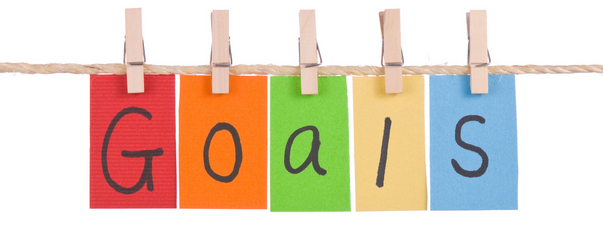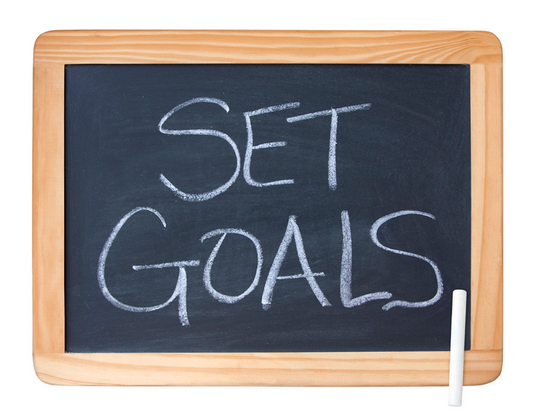Out of my recent summary of Richard Shell’s Springboard, Launching Your Personal Search for Success came several things that I want to explore further. One of them was about goal setting.
Here’s the tantalising intro to goal setting that Richard gave us in his book. (Kindle location 3819)
“In a notable study of academic achievement, researchers randomly selected college students who were struggling with their grades and conducted a simple intervention. Half the students were given a two-hour, web-based, goal-setting tutorial.
 The program led students through a five-step process to conceive, frame, and write out specific personal goals related to their future, followed by a three-step tutorial to help them lay out detailed strategies for how they would achieve the goals they had set. (control group did a personality/aptitude test). At the end of the following semester, the researchers reviewed the academic performance…. Four months later, however, the grades of the group that had received the goal tutorial had risen, on average, from 2.2 to 2.9, while the other group’s grades rose only from 2.2 to 2.3. In addition, the members of the goal-tutorial group carried heavier course loads and felt better about themselves and their academic performance. This simple intervention, in short, had materially improved the chances for these students to graduate on time and with a new, more positive attitude.”
The program led students through a five-step process to conceive, frame, and write out specific personal goals related to their future, followed by a three-step tutorial to help them lay out detailed strategies for how they would achieve the goals they had set. (control group did a personality/aptitude test). At the end of the following semester, the researchers reviewed the academic performance…. Four months later, however, the grades of the group that had received the goal tutorial had risen, on average, from 2.2 to 2.9, while the other group’s grades rose only from 2.2 to 2.3. In addition, the members of the goal-tutorial group carried heavier course loads and felt better about themselves and their academic performance. This simple intervention, in short, had materially improved the chances for these students to graduate on time and with a new, more positive attitude.”
Well, that sounds like a pretty good use of 2 hours! I had to look into it in more detail.
Dominique Morisano, Jacob B. Hirsch, and Jordan B. Peterson, “Setting, Elaborating, and Reflecting on Personal Goals Improves Academic Performance,” Journal of Applied Psychology 95 no. 2 (2010): 255-64. (See the appendix of the paper for more detail on the 8 step process that I outline below. Please see the bottom of this page for a downloadable worksheet on goal setting.)
So, what were these 8 steps?
| 1. Vision | Get students to free-write about a) their ideal future, b) qualities they admire in others, c) things they could do better, d) their school and career futures, e) things they would like to learn more about, f) habits they would like to improve. |
| 2. Label | Label the main ideas and concepts that came out of the visioning process. Take a few of these (7 to 8 in the study) and write about what a successful outcome would actually look like if realised. Ensure that each labelled goal is clear and specific. |
| 3. Prioritise | Prioritise goals from step 2. Detail specific reasons for the pursuit of each goal and consider the attainability of each goal within a self-specified timeframe. (Attainability considered as success-expectation has a large influence on motivation) |
| 4. Impact | Ask students to write about the impact that attaining each of the goals would have on their life. This exercise provides further motivation for students. (As an interesting aside on Impact, check out what Dan Gilbert has to say about Impact Bias) |
| 5. Chunk | “Many things which cannot be overcome when they stand together yield themselves up when taken little by little.”-Quintus Sertorius. This step is about getting students to break their goals up into bite sized pieces/subgoals and constructing concrete strategies for achieving ach of them. |
| 6. Obstacles | Encourage students to identify likely obstacles to each subgoal and think of strategies to over come these. |
| 7. Cap | Students cap each subgoal, ie: define what it will look like for each sub-goal to be achieved. This is about benchmarking goal attainment to help keep students focused through aiding them in monitoring their own progress. |
| 8. Committed | Students evaluate the degree to which they are committed to achieving each goal. This is about the student forming a personal contract with themselves to strive for the goals that they have defined. At the end of the exercise all documents were emailed to students for their reference*. |

*A possible improvement on this would be to get students to schedule emails to themselves (could use boomerang or set as events with reminders in google calendar) so that they are reminded on a weekly (or so) basis of their goals and their goal accomplishment timeline.
Good luck using the below worksheet in your classroom or life to help your students or yourself live and learn better 🙂
Downloadable goal setting worksheet.
______________________________________________________________________________________________
Mnemonic
For those who would like to be able to remember this 8 step process without referring to this article again, please consider the following mnemonic:
note: When i say “a friend’ or ‘a brand’ make sure you envision a specific friend and an specific brand, etc.
You’re looking into the eyes of a good friend (Vision), the camera shot zooms out and you notice that they’re wearing a new pair of glasses with a new brand (Label), You ask them how they chose this new label and they admit that it was hard to prioritise (Prioritise). Suddenly, the glasses fall of your partners nose and impact the ground (Impact). They’ve fallen into two big chunks (Chunk). You decide to walk to the hardware store to try and fix them, but your friend, who is missing their glasses, has trouble avoiding the telephone poles on the way (Obstacles). You decide that it’s best to get them a hard hat to keep them safe on the journey (Cap). The hard hat salesperson ask you out, but you have to tell them that you’re already committed (Committed).